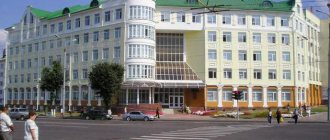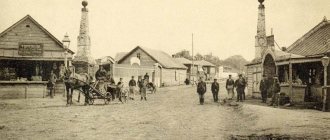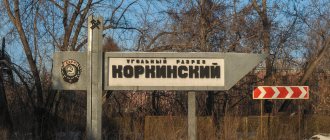Foundation of the city
On the territory of the modern city of Orel, Slavic settlements, according to archaeological data, were located back in the 12th century. But the first documentary evidence of the founding of the settlement dates back to the time of Ivan IV the Terrible, or more precisely to 1566. It was then that a fortress of the same name was founded on the banks of the Orel River to protect the southern borders of the Russian state.
Already in 1577, a Cossack settlement appeared within the city of Orel. The Church of the Intercession was built on its territory. This is the first building among many that in the future made up the sights of Orel.
Oryol Museum of Local Lore
Oryol Museum of Local Lore
Eagle
Founded by a scientific archival commission in 1897. One of the first provincial museums of the Russian Empire. The collection was assembled by the members of the scientific commission themselves: chain mail, an ancient Greek amphora, a spear, a collection of coins, bones of fossil animals. Today, the museum's holdings include 170 thousand unique items, including a collection of peasant costume, Oryol embroidery and lace. Since 1995, the museum has been publishing the collection “Notes of Local Lore”. For the 450th anniversary of the founding of the city, new halls were opened: ethnography, the nature of the region, the history of Orthodoxy in the Oryol region.
Development of the city of Oryol
Meanwhile, the settlement grew and developed. But at the beginning of the 17th century, it experienced a tragic page in history when it was destroyed by Polish invaders. In 1636, the city was restored, although it continued to be subject to raids by Tatar hordes from the Crimean Khanate.
In 1719 the city became the center of the Oryol province. Of course, not all of Orel’s sights have survived to this day. These include the famous Oryol Kremlin, which was dismantled around the same time. Since then, Orel has ceased to be a fortress.
In 1779, an almost complete redevelopment of the city took place, and already in 1796 it became the center of the Oryol province. It is from this moment that the flourishing of this settlement begins.
In the 19th century, a telegraph and telephone appeared in Orel, industry began to develop, plants and factories were built, railway and tram lines were laid. And in 1895, a power plant was built that supplied electricity to the homes of city residents.
At the same time, political life began to boil in Orel. Several populist circles were created, and by the end of the 19th century, social democratic groups appeared, among which the Bolsheviks began to gain special weight.
Population
Oryol, whose population is decreasing every year, is considered an original Russian city. The indigenous inhabitants, of course, are Russians. In percentage terms, they are about 95%. However, other nationalities also live in the territory, although there are fewer of them - 5%. There are less than 2% of Ukrainians in Orel, 1% of Chechens, Azerbaijanis, Belarusians and Armenians, and 2% of other nationalities.
By the beginning of 2000, the population was about 330 thousand people. However, by 2014 this figure had decreased by approximately 13,000 (317 thousand).
Orel in Soviet times
After the February and October revolutions, the Civil War began in Russia. The eagle passed from the hands of one opposing force to another several times. But in the end, victory remained with the Bolsheviks.
In the period after the Civil War, Orel was alternately included in administrative entities with other centers, until in 1937 it became the main city of the newly formed Oryol region.
During the Great Patriotic War, Oryol was not spared either. The city's attractions were not destroyed as a result of Wehrmacht air strikes, but residential areas were damaged. In the fall of 1941, Orel was captured by a group of troops of General Guderian. During the occupation, an underground movement was active in the city, destroying strategic targets of the German troops. Finally, in August 1943, as a result of the offensive operation "Kutuzov", Orel was liberated by the Soviet Army from the Nazi forces.
Unfortunately, the damage caused to the city by military operations was quite significant. Some sights of the city of Oryol were destroyed, structures and communications, water supply, residential buildings and administrative buildings were destroyed. So the frontier of restoration work seemed enormous. Nevertheless, the city was rebuilt within the deadline, residents returned to their homes, the work of old factories was restored and new ones were put into operation. Orel again became the cultural and industrial center of the region.
Oryol Regional Library named after. Ivan Bunin
Oryol Regional Scientific Universal Public…
Eagle
The oldest library in the region. It originates from the provincial public library. The book fund was seriously damaged during the fascist occupation; 80 thousand books were lost. After the liberation of the city, the library was able to be restored. Today the book depository is a methodological center for 542 district and rural libraries. The collections contain more than half a million books. Three thousand unique: including handwritten and early printed publications of the 16th–19th centuries, more than 35 thousand copies of local history literature.
Eagle today
Currently, Orel is the largest settlement and administrative center of the Oryol region of the Russian Federation. Its population currently exceeds three hundred thousand people. The city has a number of large industrial enterprises in the food industry, mechanical engineering, and metallurgy. The production of minerals has also been established.
But the main thing that the city of Orel can be proud of is its history and sights. This settlement literally rose from the ashes several times, thanks to the heroism and hard work of its residents. And the main attractions of Orel will be discussed below.
House-Museum of Nikolai Leskov
House-Museum of N.S. Leskova
Eagle
The life story of the creator of the “gallery of saints and righteous of Rus'” was collected in a noble nest, the city estate of the writer’s father. This is the same mansion that Leskov himself described: “Our house in Orel was on Third Dvoryanskaya Street...” The only house-museum of Nikolai Leskov in Russia was opened on July 2, 1974. The exhibition “In the World of Leskov” includes furniture and personal belongings of the writer, books, first editions, portraits and photographs. “Leskov in Fine Arts” is a collection of works by famous artists, including Boris Kustodiev and Kukryniksy. The exhibition “Family Memories” includes materials about the writer’s great-granddaughter, ballerina Tatyana Leskova.
Giant Eagle Monument
Orel has many cultural monuments. The city's attractions can be listed for quite a long time. But the main symbol of this settlement, without a doubt, is the monument to the giant eagle. It is made of a rather strange material, namely straw, which is attached to a wire frame.
This monument is located at the city's railway station. So many tourists who come to see the sights of Orel can first of all observe this sculpture.
Location of Oryol
It is located on the Central Russian Hill, which is located in the European part of Russia. In order to understand where the city of Orel is located on the map, you need to look south from the capital (Moscow), the distance is approximately 380 km. It is more than 1000 km away from St. Petersburg. Near the Oryol region there are Kaluga, Tula, Kursk, Bryansk and Lipetsk. They have common boundaries.
Orel is a city that is the center of the region. Its length from south to north is about 150 km, and its width (west-east) is more than 200 km. The Oryol region is the smallest in Russia. It also has the smallest population.
Epiphany Cathedral
We will begin to describe the historical sights of Orel from the oldest building that has survived to this day, namely the Epiphany Cathedral. It was built in the middle of the 17th century. Of course, since then the cathedral has been rebuilt and reconstructed many times, nevertheless largely retaining its original appearance. The temple underwent the greatest changes at the very beginning of the 20th century, and the last partial reconstruction was carried out in 2013. The very next year, services were resumed in the church for the first time since 1919. Today, many tourists and parishioners flock to this cultural monument and spiritual abode.
Temple of the Iveron Mother of God Icon
Temple of the Iverskaya Icon of the Mother of God in Orel
Oryol Region
Built in memory of the coronation of Emperor Nicholas II near the station and at the expense of Oryol railway workers. Even the author of the project was Nikolai Orlov, an engineer of the Moscow-Kursk Railway. The Tsar himself sent a thousand rubles for construction. The main shrine of the temple was the icon of the Iveron Mother of God - a copy of the image installed on the Resurrection Gate in Moscow. After the revolution, the church building housed a school, a clinic, a kindergarten, a store, and a warehouse. In the 60s of the twentieth century, the temple was almost demolished. Only in the 90s was the building returned to the believers, and a year later daily services were resumed in the church. And three years later, a complete restoration was completed.
Holy Dormition Monastery
The Holy Dormition Monastery has a rather interesting, but tragic history. Its construction dates back to 1686. Every year the number of novices increased, and the territory belonging to the monastery increased. New buildings were erected, which today would undoubtedly be included in the sights of Orel.
But with the Bolsheviks coming to power, the situation changed dramatically. The buildings of the monastery began to be used for purposes other than their intended purpose, and many were redesigned or destroyed. And after the war, a children's labor colony was organized on the territory of the former monastery. Thus, by 1980, almost all the old buildings were destroyed, except for the Trinity Church.
However, almost immediately after the collapse of the Union, attempts were made to reconstruct the Cathedral - to make it as close as possible to its former state. Already in 1996, monastic life began again in the monastery. In subsequent years, reconstruction continued, and by 2008 it was largely completed.
Oryol Museum of Fine Arts
Oryol Museum of Fine Arts
Eagle
The collection began with the collection of Anton Nikolaevich Nikolaev. The opera singer donated over 200 paintings. Oryol residents donated family portraits to the provincial museum. The Novosiltsovs, the Strakhovichs, the Skoropadskys... The “granted” portraits received by representatives of the Kurakin family from the tsars have high artistic merit. Now paintings from the 18th century can be seen in museum halls. The collection is constantly being replenished: former Jack of Diamonds, artists from the sixties, representatives of the Moscow school of the 60-80s. During expeditions to the regions of the region, a folk art fund is formed.
State Museum named after I. S. Turgenev
One of the attractions of the city of Oryol is the State Art Museum named after I. S. Turgenev. It is not one building, but a whole complex of buildings located throughout the city. Once these were separate museums, but then it was decided to combine them into a single structure.
Actually, the main building was built back in 1860, but then it had a different purpose. It began to serve as a museum of the great Russian writer, miraculously saving itself from bombing, only in 1945. Since then, his farm has grown significantly and was replenished with a large number of historical exhibits.
Popular message topics
Planting in the country: Used as an unusual, wild plant. In large quantities they create a bluish color. Eryngium takes root well in sandy soil. As seedlings, the plant practically does not take root in place.
From time immemorial, rulers of states have sought to strengthen their dominance, seize lands, and have as much power and values at their disposal as possible. This was the reason for the military campaigns of the pharaohs. However,
Russia is rich in beautiful places, forests and rivers. One of the largest rivers in all of Europe is the Volga. This amazingly beautiful and stormy river originates from the Tver region. It flows through several countries and regions,
Other attractions
Of course, the sights of Orel include much more buildings and structures than the number that we have discussed in detail. These include the museums of Andreev, Bunin and Leskov, the Regional Art Gallery, Boris and Gleb Cathedral, the churches of St. Sergius of Radonezh and St. Nicholas of Rybny, the Vvedensky Monastery, the House of Governors, monuments to Turgenev, Fet, Lomonosov, Bunin, Lenin, Dzerzhinsky...
And even this is not a complete list, but only a list of the most famous attractions of this regional center. The history of Orel was quite interesting and turbulent, but, despite the tragic periods in the life of the city, many cultural values still managed to survive to this day to please the eyes of citizens and tourists.
House-Museum of Ivan Bunin
Museum I.A. Bunina
Eagle
The path from a correspondent for the provincial newspaper “Orlovsky Vestnik” to a classic of Russian and world literature. The exposition of the Bunin Museum reveals the writer’s fate full of drama. The unique collection has been collected for more than half a century. It is based on documents from Bunin’s family and literary archives, photographs and manuscripts, letters and lifetime publications. The museum’s special pride is the writer’s Parisian office. Forty years ago, memorial furniture was delivered to Orel from the capital of France, including Ivan Bunin’s desk and his chair. Even in the “window” of the office there are not Oryol lanes, but Jacques Offenbach Street in Paris.
Cultural heritage
“City on the Oka” - this is how those who consider themselves a native resident of such a beautiful city as Oryol affectionately call their native land. The population here honors its history and constantly supports the cultural development of the regional center. Residents respect the works of Russian writers such as Turgenev, Bunin, Fet, Andreev, Rusanov, Granovskaya. After all, these names are known to everyone. In Orel there is a famous cultural monument - the Nobles' Nest (Turgenev's estate). The largest source of the Volga, the Oka River, originates here. The city is also famous for the fact that in 1943, on August 5, the first fireworks went off in Orel and Belgorod in honor of liberation from German occupation. This testifies to the courageous character of the residents.
Orel is considered a “green” city. Both in the very center and beyond, the level of vegetation exceeds 7% of the occupied area.
Monuments
A distinctive feature of the city is its literary heritage (it is the birthplace of the famous writers mentioned above) and architectural monuments. In the very heart of the city - on Karl Marx Square - a mighty horseman rises. This is General Alexey Ermolov. The sculpture was erected in 2012. In the Northern District there is a monument to Alyosha the steelmaker. In the shopping part of the city, opposite the central department store, there is Tankmen's Square, which is guarded by a guard of honor. In memory of the fallen soldiers, an eternal flame burns.
Moscow Sretenskaya Theological Academy
Alexey Laushkin 11/28/201628651
Sretensky Theological Seminary, located in the center of Moscow, receives applicants from different, sometimes even the most distant corners of our vast country.
After completing their studies, many of them will return to serve God and His holy Church in their small homeland. The website of the Sretensky Theological Seminary continues the series of photo galleries of the native places of the students of our seminary. 2nd year student Alexey Laushkin entered the seminary from the Oryol Metropolis of the Russian Orthodox Church. His photo story is about the region from which he came.
Eagle
Orel is a city that arose on the site of an ancient settlement at the confluence of the Oka River and its tributary Orlik.
By decree of Ivan the Terrible in 1566, a fortress was founded here to protect against the Crimean Tatars, which laid the foundation for an amazing city. The city got its name in honor of the Orlik River. Oryol is located in the European part of the country. The distance from Moscow to the southwest is only 368 kilometers. Currently, the city of Orel is the center of the Oryol region. In 2007, Orel was awarded the title “City of Military Glory.” The coat of arms of the city of Oryol is a historical coat of arms, approved in 1781. The station square is decorated with a sculpture of an eagle - a unique landmark of the city named after this bird.
Monument to the founder of the city Ivan the Terrible
Symbol of the city of Orel on the station square
Literary capital of Russia
Oryol rightfully bears the unofficial title of one of the literary capitals of Russia. The streets and squares of the city keep the memory of the great masters of words I.S. Turgeneva, N.S. Leskova, A.A. Feta, M.M. Prishvina, I.A. Bunin and L.N. Andreeva. The population of Orel is just over 300 thousand people, but its literary heritage can cover the whole of Russia.
Monument to the writer I.A. Bunin
Monument to the writer Leskov N.S.
Monument to the writer I.S. Turgenev Nobles' Nest is a park located on the left bank of the Orlik River. Once upon a time there was the estate that I.S. Turgenev described it in his work of the same name. In 1903, a garden was opened in the park and a bust of the writer was installed. Performances were often staged in the garden, and musical concerts and general celebrations took place here. The park has been and remains a favorite vacation spot for residents of the city of Orel.
Spasskoye-Lutovinovo creative workshop of the great writer
Turgenev's house in Spassky is inextricably linked with the memory of the writer's work. A description of Spassky-Lutovinov, his shady linden alleys and surrounding areas can be found on the pages of “Notes of a Hunter” and other stories by Turgenev, which glorified the amazing beauty of the nature of the Oryol region throughout the world. Estate of I. S. Turgenev.
Estate of I. S. Turgenev. It is worth noting that the temple has been closed since the early 30s. The exterior of the temple (with the bell tower) was restored only in the early 1970s, after which the premises were again used as a museum exhibition hall. In 2000, after restoration work, the temple was re-consecrated and opened to parishioners.
Internal structure of the Transfiguration Church in the village of Spasskoye-Lutovinovo.
Nature of the village "Spasskoye-Lutovinovo".
Autumn landscape of the village "Spasskoye-Lutovinovo".
City of the first fireworks
City Day in Orel is celebrated on August 5th. On this day back in 1943, an artillery salute was given to the troops in Moscow in honor of the liberation of the cities of Orel and Belgorod during the Battle of Kursk. This fireworks display was the first during the Great Patriotic War, so Orel and Belgorod were given the name “the city of the first fireworks.” The history of the military past of the Oryol region is reflected in the exhibitions of the military history museum.
Military History Museum
Military History Museum (side view)
Temples of the city of Orel
The spiritual life of the city's residents is closely connected with the church. The city's attractions are mostly churches, cathedrals and Orthodox churches. Oryol is a city of temples.
Epiphany Cathedral
Temple of the Smolensk Icon of the Mother of God
Cathedral of the Archangel Michael
Akhtyrsky Cathedral
Oryol Orthodox Gymnasium - a pearl of the Orthodox faith for children
Since 1998, in our native Oryol region, with the blessing of His Holiness Patriarch of Moscow and All Rus' Alexy II, the Oryol Orthodox Gymnasium began its existence in the name of the Hieromartyr John Kuksha. It was in this educational institution that I studied and received a certificate of complete secondary education.
Territory of the Holy Dormition Monastery The gymnasium is located on the territory of the Holy Dormition Monastery, which is a favorable environment for children to learn the Orthodox faith. Students, young and old, actively participate in the active life of their gymnasium church.
Line on the first of September in the Orthodox gymnasium
Service in the gymnasium church
Graduates - good luck! A bright and memorable event for the students of the gymnasium was the first visit to the Oryol land of Patriarch Kirill, which took place on July 28, 2016. The gymnasium students amicably greeted the head of the Russian Orthodox Church, and then attended the patriarchal service. I still remember this event with trepidation.
Meeting of the Patriarch with students of the gymnasium and believers of the city of Oryol. The solemn service took place in the Epiphany Cathedral in the city of Orel.
Patriarchal service in the Epiphany Cathedral in Orel.
The unique nature of the Oryol region
There are many unique natural monuments located on Oryol land. One of the most amazing is the Oryol Polesie National Park. More than 30 rare plants grow on the territory of the national park. Rare species of animals such as bison, Siberian iris and many others are raised and preserved here.
The main entrance to the Oryol Polesie The inhabitants of the Oryol Polesie are bison.
Alexey Laushkin
2nd year undergraduate student
Key words: My land, Orel, Orthodoxy, mission, sermon









